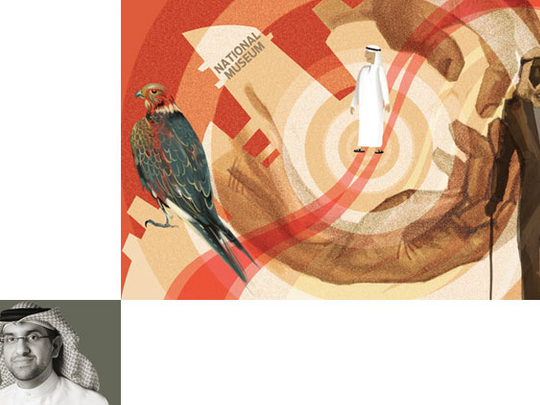
Billions of dollars are being spent by the Gulf states on cultural projects and museums, including ones dedicated to photography, cars and calligraphy. However, the most important of these projects are the so-called ‘national’ museums, that ideally would tell the story of the country.
Major projects are in the pipeline such as Qatar’s $434 million National Museum covering 46,000 square metres, that was awarded in September 2011 to South Korean firm Hyundai and is due to open in 2017.
Abu Dhabi is expected to soon award a contract to build the 66,000-square-metre Zayed National Museum.
Riyadh, Kuwait City and Manama host larger national museums while smaller ones exist in Muscat and the various emirates of the UAE. Many of the museums in the Gulf are not referred to as national museums per se, but they do play a part in portraying the narrative.
In my repeated visits what I find even more interesting about what is shown in these national museums is what isn’t on display. These museums have become tools to propagate the ‘approved’ narrative of the state. In most museums in the Gulf we see the elements of the prehistoric era, the advent of Islam and a sudden jump to the era of the current ruling family.
Missing are tribal feuds, assassinations and in a number of instances, massacres that took place. Since some would argue that these issues are too sensitive to tackle so soon, I have compiled a number of missing factors that are less contentious.
Minorities
None of the Gulf states’ national museums tackle the role or even the existence of minorities and other ethnic and religious groups. For instance, none of the museums portray Shiite culture, life, beliefs and customs. In fact, the word ‘Shiite’ doesn’t appear anywhere, nor for that matter do photos or names of Shiite religious leaders or individuals.
The same applies to the native Hindu, Christian, Ismaili, Jewish, Baloch and Persian minorities as well as those with Asian, African and other backgrounds. I am sceptical of claims that highlighting the ‘other’ will exaggerate differences and put them under the microscope. On the contrary, acknowledging and celebrating their roles and lives in a respectful manner would reinforce social cohesion and understanding.
Women
A visit to the Gulf states’ museums may leave one wondering if any women had ever lived in the Gulf at all given their complete absence from the state approved narrative.
Most museums in the Gulf display intricate textiles and embroideries worn by women, but no women are identified by name or photos; they are sidelined even in their country’s museums. The fact that women have been so neglected in official state museums prompted the former president of the Arabian Gulf University Dr Rafia Ghubash to establish a dedicated ‘Women Museum’ to highlight the role of women in UAE history.
Other governors
The history of the Gulf states over the past 500 years included various shaikhdoms, kingdoms and tribal governors whose rule stretched well into other states for months, years or scores of years. The museums fail to acknowledge the presence of the other ruling tribes, families or individuals of these territories who are not related to the current ruling families.
One story I came across recently was of a Gulf state that had a border disagreement with its larger neighbour. During the negotiations, the larger neighbour referred to the house of a member of its ruling family that was well inside the other country’s border. The authorities of the smaller country solved the misunderstanding by demolishing the century-old house.
The slave trade
According to The Gulf States: A Modern History by David Commins, most of the Gulf slaves were captured from Africa’s interior and transported via East African ports to Arab Gulf states to work as pearl divers, sailors, dock workers as well as in agriculture and other labour intensive work (many were bought in Iran and India as well).
At the height of trade in the mid-19th century, approximately 2,000 to 3,000 slaves were transported from Africa to Arabia annually. Slavery was abolished in Bahrain in 1937 and in Kuwait in 1947, according to Charles W.W. Greenidge while the Encyclopaedia of Diasporas states that Qatar abolished slavery in 1952, Saudi Arabia did so in 1962 and the other Trucial Gulf States (UAE and Oman) did so the following year. And yet none of the dozens of museums of the Gulf even mentions them, let alone their plight and contribution.
Role of expatriates
The Gulf states today host over 20 million expatriates some of whom have been living and working here for over half a century. Around 40 per cent of the region’s population is expat and in the UAE and Qatar that percentage increases to 90 per cent.
Despite their countless contributions the presence of these non-citizens is not acknowledged in any of the museums of the Gulf.
Gulf museums suffer from low footfall and a lack of interest among the general public. Perhaps that is because so few museums tackle pertinent issues such as the toll that the rapid development in the Gulf is taking on the environment for instance, the demographic imbalance or the presence of tens of thousands of bidoons (stateless individuals) in these countries.
Instead the Gulf states use these museums, along with school text books, state TV, radio and newspapers to establish an artificial narrative of uniformed singular national identity that at best ignores and at worst negates the presence of the ‘other’ in order to reinforce pre-approved notions.
Museums in the Gulf may very well continue to be tools to recast the modern history of the states through a government-approved narrative. Alternatively, they could be transformed into arenas that through documentation, study and interpretation provoke critical thinking, the acknowledgment of others and finally a celebration of diversity.
Sultan Sooud Al Qassemi is a non-resident fellow at the Dubai School of Government. You can follow him at www.twitter.com/SultanAlQassemi









